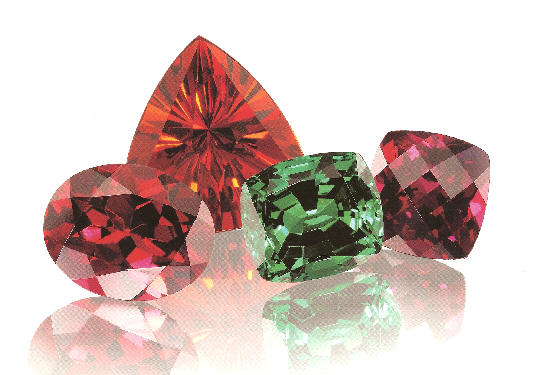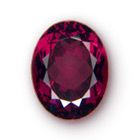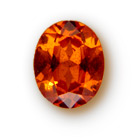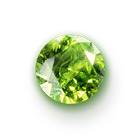GARNET
JANUARY
BIRTHSTONE
 Garnets
- aren’t these the wonderfully deep red gemstones which are often
found in antique jewelry? Well, this is only the partial truth, as a warm and
deep red is indeed the most frequently occurring color for Garnets. But
unfortunately only few people know that the realm of Garnets holds many more
bright and beautiful colors.
Garnets
- aren’t these the wonderfully deep red gemstones which are often
found in antique jewelry? Well, this is only the partial truth, as a warm and
deep red is indeed the most frequently occurring color for Garnets. But
unfortunately only few people know that the realm of Garnets holds many more
bright and beautiful colors.
The traditional image of Garnet has been brightly
transformed by spectacular founds, mainly from Africa. Although red remains the
major color, Garnets today easily adapt to any new color trend in fashion due to
the rich range available. And because of the new founds, there are reliable
sources for steady supply in these fancy colors. All this explains why this very
gemstone family manages to keep on providing new impulses for the jewelry events
in our days.
An expert will understand "Garnet” as the denomination for a group of over ten
different gemstones with a similar chemical structure. Although the color red is
the one which occurs most frequently, there are also Garnets showing different
shades of green, pale to bright yellow, fiery orange and fine earth- and
umbra-shades. Only blue is a color which is not available in Garnet. Garnets are
gemstones which are in high demand and are often worked into pieces of jewelry -
especially since today not only the traditional gemstone colors red, blue and
green are cherished by the consumer, but the intermediate shades and hues are
also very popular. Besides the realm of Garnets also possesses rarities such as
asterism or atones which change their color from daylight to artificial light.
What else characterizes this gemstone family? First of all, there is the
excellent hardness of 7 to 7.5 on the Mohs’ scale. This applies, with minor
variations, to all the members of the Garnet group. And this is also an
explanation why these gemstones are so excellent to wear. Garnets are quite
sturdy and resistant to everyday wear and tear, and uncomplicated to work into
jewelry. Only to hard impact or uncontrolled heating they will react adversely.
Another point in favor of Garnets is their high refraction of light, the reason
for the amazing brilliance of Garnets. The shape of the rough crystal is also
interesting. Garnet, after all, means something like "the grainy” and is derived
from the Latin word "granum” meaning "grain”. This refers to the typically
rounded shape of Garnet and also reminds of the seeds of the pomegranate. In the
middle ages, Garnet was also called "karfunkel” in German, referring to the
glowing red reminding of the sparks of fire. Today there are a lot of
imaginative names used in the trade, such as Arizona Ruby, Arizona Spinel,
Montana Ruby or New Mexico Ruby.
Garnet helped guide Noah
Garnets have been widely known for thousands of years.
Even Noah, it is reported, used a lantern from Garnet in order to safely steer
his Ark through the darkness of the night. Garnets are found in jewelry from
ancient Egyptian, Greek and Roman eras. Many courageous discoverers and
travelers wore Garnets for protection, as they were considered popular talismans
and protective stones, because it was believed in those days that Garnets
illuminate the night and prevent their wearer from any sort of evil. Today
science explained to us that the proverbial luminosity of Garnet is caused by
its high refraction of light.
Garnets come not only in many colors but also under many names: Andradite,
Demantoid, Grossularite, Hessonite, Pyrope, Rhodolite, Tsavorite, Spessartine,
Uvarovite etc.. Let us focus on the most important ones, and let us start with
red Garnets. First of all, there is fiery red Pyrope. Its fierce and often
slightly bronze coloured red was highly popular as gemstone color in the 18th
and 19th century. Worldwide renowned in those days were the Bohemian Garnets
from an occurrence in the north-eastern part of the former Kingdom of Bohemia -
small stones in a wonderful color. In Europe they were frequently used for
jewelry in Victorian times. This genuine Bohemian Garnet jewelry is
traditionally decorated with many small stones which are tightly arranged along
each other like the seeds of a pomegranate. Today Garnet is still found in the
Czech Republic, and the stones are still arranged in the traditional way,
tightly joined, so that the attraction of the classical Garnet jewelry is caused
by the beauty of the stones only.
The large central stones of the typical "rosette" arrangements are usually also
Garnets, but these come from another category. Almandines, named after the
ancient gemstone city of Alabanda in Asia Minor, are c a little different in
their chemical structure from Pyropes. Why these are preferred as central
stones? Well, Nature only grows Pyropes in small sizes, but allows for Almandine
crystals in larger dimensions.
 Another red Garnet
variety is Rhodolite, a crystal mixture from Almandine and Pyrope This popular
red Garnet shows a wonderful velvety red with a fine purple or raspberry
coloured undertone. Originally discovered in the USA, it is mainly found in
gemstone mines in East Africa, India and Sri Lanka nowadays.
Another red Garnet
variety is Rhodolite, a crystal mixture from Almandine and Pyrope This popular
red Garnet shows a wonderful velvety red with a fine purple or raspberry
coloured undertone. Originally discovered in the USA, it is mainly found in
gemstone mines in East Africa, India and Sri Lanka nowadays.
The fantastic find of an up to then extremely rare
Garnet variety puzzled experts all over the world some years ago. On the Kunene
river, on the border between Namibia and Angola, there was the surprising and
spectacular discovery of bright orange to red Spessartine Garnets, which were
originally named after their occurrence in the German Spessart mountains. Until
the legendary mine was discovered in Namibia, Spessartines had existed as mere
collector’s items or rarities. They were hardly ever used for jewelry because
they were so rare. But the found changed the world of jewelry gemstones. From
this time on, an exceptionally fine and brightly orange-red gemstone has
completed the offered range. The trade name "Mandarin -Garnet” was coined, and
the wonderfully orange coloured Fine Garnet became world-famous almost over
night. Unfortunately the mine in the remote Namibian mountains could only be
exploited for a few years. Prospecting for the gemstones in the isolated bush
land became more and more complicated and expensive It had to be expected, then
, that the very upstart among the quality gemstones would only be available in
limited amounts from the stocks of few cutters. However, another sensation was
caused by discovering another occurrence of the orange-coloured treasures, this
time in Nigeria. In color and brilliance they are so similar to the Namibian
stones that only experienced experts will be able to tell them apart.

A bounty of color
 And now let us
focus on green Garnets. Green Garnets - do they really exist? Of course! There
are even several known green Garnet varieties. First of all, there is
Grossularite, which was created by Nature in many fine colors from yellow to
green and brown, and which is especially cherished because of the many
in-between shades. And earth-colors. Here there was also a sensational found: In
the last year of the 20th century large Grossularite occurrences were discovered
in Mali. The Mali Garnets are charming because of their high brilliance, which
makes even the usually not so popular brown color attractive and vivid, and the
natural appeal is in wonderful harmony especially with ethno-look inspired
trends.
And now let us
focus on green Garnets. Green Garnets - do they really exist? Of course! There
are even several known green Garnet varieties. First of all, there is
Grossularite, which was created by Nature in many fine colors from yellow to
green and brown, and which is especially cherished because of the many
in-between shades. And earth-colors. Here there was also a sensational found: In
the last year of the 20th century large Grossularite occurrences were discovered
in Mali. The Mali Garnets are charming because of their high brilliance, which
makes even the usually not so popular brown color attractive and vivid, and the
natural appeal is in wonderful harmony especially with ethno-look inspired
trends.
Possibly the most famous green Garnet is Tsavorite, another Grossularite.
Tiffany’s in New York re-named the stone which had been discovered in 1967 by
British geologist Campbell R. Bridges in North-East Tanzania. The emerald-green
stone was named after its occurrence near the famous game park Tsavo-National
Park. Tsavorite is of a vivid light to velvety deep green and, like all other
Garnets, of strikingly high brilliance.
The star among green Garnets is rare Demantoid, a gemstone for connoisseurs and
lovers. It shows enormous brilliance, higher even than that of Diamond. Russia’s
leading court jeweler Carl Fabergé loved the brilliant green Garnet from the
Urals more than any other stone, and liked to use it in his creations. Nowadays
Demantoid turns up more often in the gemstone market because of the new founds
in Namibia. Demantoids from Namibia show good color and brilliance, however,
they lack s minor characteristic: the so-called "horsetail-inclusions”, fine
bushy-shaped inclusions which are the characteristic birthmark identifying
Russian Demantoids.]
If you love the immaculate naturalness and sun-drenched
warm colors of Indian summer, you will fall in love with range of colors
displayed by Garnets. Today these stones come mainly from African countries,
also from India, Russia, central and south America. The skilled hands of cutters
all over the world shape them in many classical forms and more and more also in
modern fancy designer’s cuts. Garnets appeal generally because of their natural
and not manipulated beauty, their wide variety of colors and their magnificent
brilliance. If you buy Garnet jewelry you can be certain to enjoy this gemstone
gift from Nature permanently and without inhibitions.
Back
Home
Links
Spotlight
on TKPinc
FAQ
Gem
Information
 Garnets
- aren’t these the wonderfully deep red gemstones which are often
found in antique jewelry? Well, this is only the partial truth, as a warm and
deep red is indeed the most frequently occurring color for Garnets. But
unfortunately only few people know that the realm of Garnets holds many more
bright and beautiful colors.
Garnets
- aren’t these the wonderfully deep red gemstones which are often
found in antique jewelry? Well, this is only the partial truth, as a warm and
deep red is indeed the most frequently occurring color for Garnets. But
unfortunately only few people know that the realm of Garnets holds many more
bright and beautiful colors.  Another red Garnet
variety is Rhodolite, a crystal mixture from Almandine and Pyrope This popular
red Garnet shows a wonderful velvety red with a fine purple or raspberry
coloured undertone. Originally discovered in the USA, it is mainly found in
gemstone mines in East Africa, India and Sri Lanka nowadays.
Another red Garnet
variety is Rhodolite, a crystal mixture from Almandine and Pyrope This popular
red Garnet shows a wonderful velvety red with a fine purple or raspberry
coloured undertone. Originally discovered in the USA, it is mainly found in
gemstone mines in East Africa, India and Sri Lanka nowadays.
 And now let us
focus on green Garnets. Green Garnets - do they really exist? Of course! There
are even several known green Garnet varieties. First of all, there is
Grossularite, which was created by Nature in many fine colors from yellow to
green and brown, and which is especially cherished because of the many
in-between shades. And earth-colors. Here there was also a sensational found: In
the last year of the 20th century large Grossularite occurrences were discovered
in Mali. The Mali Garnets are charming because of their high brilliance, which
makes even the usually not so popular brown color attractive and vivid, and the
natural appeal is in wonderful harmony especially with ethno-look inspired
trends.
And now let us
focus on green Garnets. Green Garnets - do they really exist? Of course! There
are even several known green Garnet varieties. First of all, there is
Grossularite, which was created by Nature in many fine colors from yellow to
green and brown, and which is especially cherished because of the many
in-between shades. And earth-colors. Here there was also a sensational found: In
the last year of the 20th century large Grossularite occurrences were discovered
in Mali. The Mali Garnets are charming because of their high brilliance, which
makes even the usually not so popular brown color attractive and vivid, and the
natural appeal is in wonderful harmony especially with ethno-look inspired
trends.